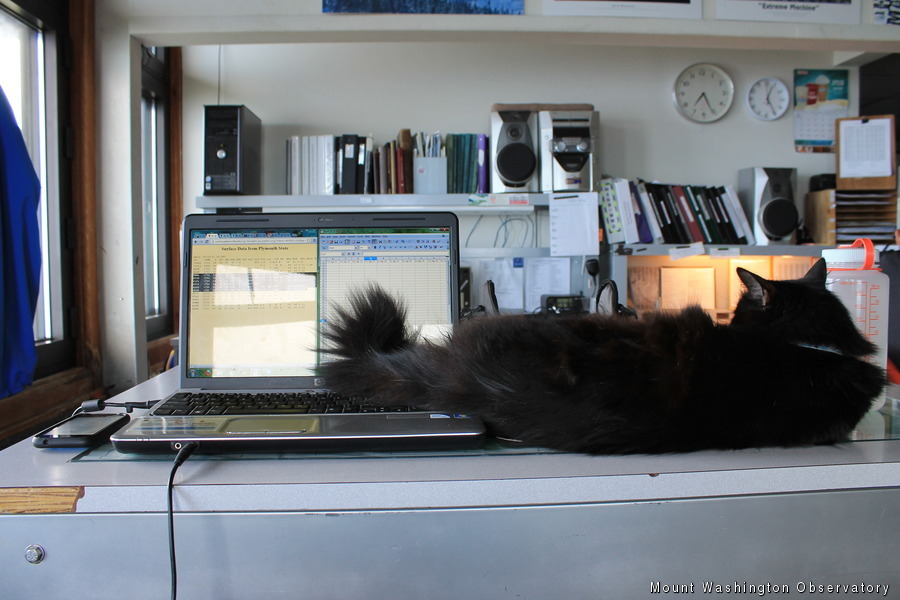Intern Observer Comment – Week Two
2013-07-17 23:20:58.000 – Matthew Cann, Summit Intern
Marty Kitty – My research assistant.
My name is Matt Cann and I am not a typical member of the Mount Washington Observatory crew. I am a summit intern, but I do not share the same duties as my fellow interns. So what do I do? Well, starting this summer, the Observatory decided to implement a fifth summer intern whose sole responsibility is to conduct research. Being positioned on the summit allows me to better familiarize myself with the White Mountain’s unique weather, as well as permit me access to the Observatory’s vast record of historical weather data. My research is a utilization of the exciting and recent partnership between the Observatory and Plymouth State University. The Director of Research at the Mount Washington Observatory and Research Assistant Professor at PSU, Eric Kelsey, and I will be working together to evaluate how accurate a weather forecasting model can predict weather conditions in the White Mountains.
We are currently able to receive forecasts from two models provided by the National Centers for Environmental Prediction (NCEP): the North American Mesoscale Forecasting System (NAM) and the Global Forecasting System (GFS). Eric and I will be testing the Weather Research and Forecast model (WRF) and its ability to forecast compared to the models we currently use to make our forecasts on the summit. The WRF model will be run by Eric on the servers at Plymouth State University to forecast three-day periods for four selected weather situations from 2012; the situations include a summit blizzard, the record heat wave of early spring in March, a heavy rain event and a thunderstorm event. The forecasts will be checked for accuracy with the archived data from 26 sites throughout the White Mountains, from summit to valley floor. The bulk of the weather stations are from MWObs’ extensive Mesonet, which includes the auto-road vertical profile as well as many popular ski areas in the White Mountains.
The WRF is known to be skilled at forecasting for unique and difficult terrain similar to the White Mountains. The hope of my research is to discover that the WRF has a very high ability to forecast for the region. If so, forecasters will be able to use the model to improve forecasts for the higher summits and valleys of the White Mountains. The long-term goal of this project is to build a stronger relationship with the local White Mountain ski areas by providing them more accurate forecasts via the WRF.
If you are interested in local weather, I recommend visiting the Mount Washington Observatory and the Plymouth State Weather Center for more information.
Matthew Cann, Summit Intern
Team Flags Return for Seek the Peak’s 25th Anniversary
Team Flags Return for Seek the Peak's 25th Anniversary By MWOBS Staff Mount Washington Observatory is looking forward to continuing a much-loved tradition for Seek the Peak’s 25th Anniversary: Team flags. In inviting teams
Meet Summer Interns Zakiya, Max and Maddie
Meet Summer Interns Zakiya, Max and Maddie By MWOBS Staff We are excited to welcome six teammates to the summit of Mount Washington this summer! During their internship, these students and graduates will play
Saying Goodbye to the Summit
Saying Goodbye to the Summit By Alexis George After an extraordinary last three years working as a Weather Observer and Meteorologist, I am excited to pursue a different career. As sad I as am






